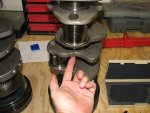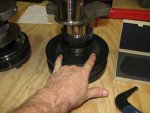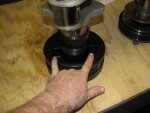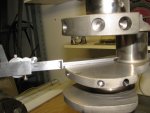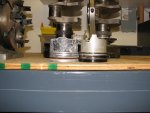Best info I have is that the LB7 and LLY cranks are the same, and the LBZ and LMM cranks are the same.
But the two cranks are not interchangeable. The LLY/LB7 crank has ~ .075" larger counterweight radius which will hit LBZ/LMM pistons or be really, really close to hitting.
And the LBZ/LMM crank needs more external balancing weight, the flexplate has 4 large holes to balance, and the LLY/LB7 has only 3. The harmonic balancer on the LBZ is about 180° worth of weight, and the LLY is only 120°.
If the flex plate or harmonic balancer is still in place, it's easy, but sometimes it isn't.
You can measure the counterweight radius with calipers, but that's a bit iffy if you aren't really confortable with calipers. From the top of the rod journal to outside of the weight at BDC, it's 4.110" on the LBZ and 4.185" on the LLY.
But there is an easier way. There is a lump on the casting of LBZ cranks on the counterweight closest to #2 cylinder (second counterweight from the front). See pics:
But the two cranks are not interchangeable. The LLY/LB7 crank has ~ .075" larger counterweight radius which will hit LBZ/LMM pistons or be really, really close to hitting.
And the LBZ/LMM crank needs more external balancing weight, the flexplate has 4 large holes to balance, and the LLY/LB7 has only 3. The harmonic balancer on the LBZ is about 180° worth of weight, and the LLY is only 120°.
If the flex plate or harmonic balancer is still in place, it's easy, but sometimes it isn't.
You can measure the counterweight radius with calipers, but that's a bit iffy if you aren't really confortable with calipers. From the top of the rod journal to outside of the weight at BDC, it's 4.110" on the LBZ and 4.185" on the LLY.
But there is an easier way. There is a lump on the casting of LBZ cranks on the counterweight closest to #2 cylinder (second counterweight from the front). See pics:



